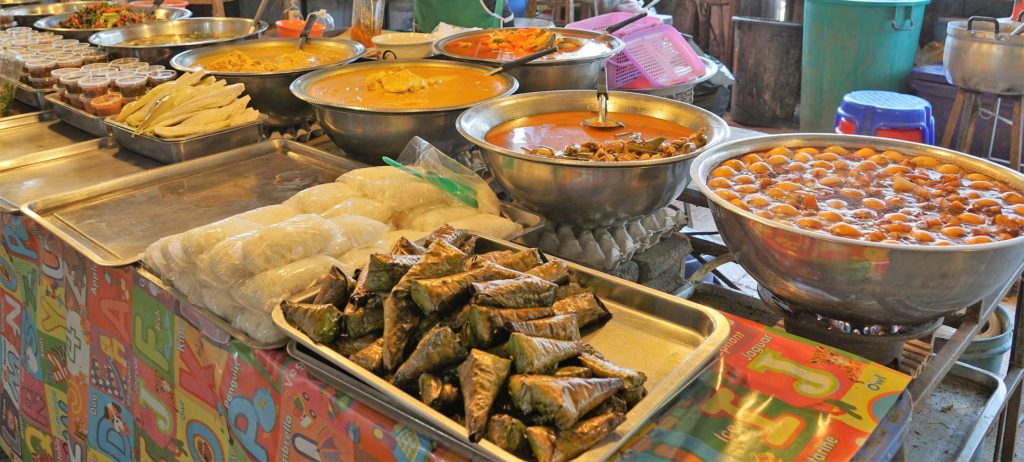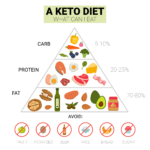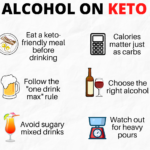Are you a vegetarian or vegan wondering if a Keto diet (low carb, high fat, and moderate protein) could work for you?

The mainstream thinking is a Keto diet is chock full of animal protein. At first glance it doesn’t look like a vegetarian or vegan-friendly diet, does it?
But having said that, a plant-based Keto diet can be accomplished with some adjusting.
If you mindfully design your plant-based Keto diet you will find plenty of protein, micro and macronutrients in eggs, herbal supplements, and some other places.
Typically vegetarians consume a lot of legumes. However, legumes aren’t part of the Keto diet due to their large number of carbohydrates in them. Eating legumes will take you out of the fat-burning state of “ketosis”, the diet’s namesake.
The trick for the would-be Keto vegetarian/vegan is to find foods that are low in carbohydrates and nutrient-dense. How easy this is to do depends on what type of vegetarianism you follow.
In this article we’ll also take a look at some potential benefits, some of the top foods to include in your diet, and how to meet some of the common challenges of eating a Keto diet as a vegetarian or vegan.
Vegetarian types
In general, a vegetarian is someone who doesn’t eat meat and perhaps won’t’ eat other animal products like cheese or honey. There are a few different types of vegetarians. Here’s a short, probably not complete, list of vegetarian types:
-
- Pescatarians include fish and seafood, dairy, and eggs, avoiding meat and poultry.
- Lacto-ovo vegetarians include dairy and eggs, avoiding fish, poultry, and meat. This is the primary vegetarian diet for most of the western world.
- Lacto vegetarians will include dairy and avoid meat, fish, poultry, and eggs.
- Vegans diets are completely plant-based avoiding all animal products, including honey.
The more restrictive the plant-based diet, the greater the challenge to build a healthy Keto diet. For example, a pescatarian wouldn’t have much trouble consuming enough protein, B12, or omega-3 fatty acids from fish. But a vegan would most likely have to take an omega-3 supplement derived from a plant source like algae. This article will focus primarily on how to build a ketogenic diet from the Lacto-ovo vegetarian diet, the primary vegetarian diet for most of the western world.
What is a vegetable-based Keto diet?
There are a variety of reasons for choosing to eat a plant-based diet. They could be ethical or religious reasons or a conscious decision to reduce your own carbon footprint. Arguably the most common reason is to eat a plant-based diet for health and wellness.
Whatever your reason there are a number of ways you can adjust the Keto diet to be more in line with a plant-based diet.
-
- A vegetarian Keto diet is nothing more than a Keto diet without animal protein sources. The objective still is to consume a primarily high-fat, low-carb diet with the goal of keeping your body in the ketosis state.
- A vegan Keto diet has the same goal without consuming any animal products (meat, fish, poultry, eggs, dairy, honey, etc.). Eating Keto as a vegan is the most challenging way to go because a lot of the vegan protein sources are full of carbohydrates. But it’s not impossible given sufficient planning and you have resolved to make it work.
Considerations for vegetarians and vegans on the Keto diet
Some considerations for being on a low carbohydrate plant-based diet fall into three general areas regarding protein, fatty acids, and micronutrients.
Protein
Without eating meat and fish, a Keto vegetarian has to be especially diligent to get enough protein in their diet. What’s the deal with protein? Although all macronutrients are essential for good health, you can argue that protein is the most essential one.
Carbohydrates may be the least essential of the macronutrients. Our bodies will synthesize glucose with a process called gluconeogenesis.
Fats are essential. Not as essential as protein, but more so than carbohydrates. Our bodies carry a lot of fat stores to be used as backup energy. Even though fat is a great source of energy, carbohydrates provide energy as well.
More to do with protein. Proteins make up the structure of our body’s tissues. Protein provides us with amino acids that are used for muscle growth, the formation of hormones, and the healing of wounds. None of the other macronutrients can do what protein does.
Complete proteins (proteins containing the full range of amino acids) are provided in meat and fish. It’s possible, though difficult, to get the full range of proteins from plants, especially on the Keto diet devoid of grains and legumes.
The essential fatty acids
Meat and fish have large amounts of omega-6 and omega-3 essential fatty acids. One of the essential omega-6 fatty acids, arachidonic acid, regulates immunity, helps to structure cell membranes, and helps in the brain’s reward signaling.
Omega-3 fatty acids are important too. Both EPA and DHA found in seafood have wide-ranging functions. Some of the areas they have been found to influence are maintaining healthy inflammation levels, brain functions, and even mood control.
The micronutrients
Some micronutrients such as carnosine, taurine, and creatine are only found in meat. Iron is another micronutrient primarily found in meat. Iron is found in plant foods also, but it’s not as bioavailable as the form of iron found in meat (heme iron).
It’s quite challenging to get enough of the B-vitamins with a plant-based Keto diet. B12 is most readily available in meat, and B1 and B3 are most abundant in starchy foods.
So how does a vegetarian eat a Keto diet?
Follow these four tips to get the most from your vegetarian Keto diet. Keep in mind the focus of this article is directed at the Lacto-ovo vegetarians, the primary vegetarians across most of the western world.
1 – Eggs (if you choose)
Eating eggs will take care of most of the protein concerns of a vegetarian Keto diet. The protein in eggs is one of the most bioavailable proteins out there.
Eggs also check off the concerns about not getting enough fatty acids. They are rich in arachidonic acid, an omega-6 fatty acid. Pasture-raised chickens, versus those from a factory farm, provide omega-3 acids too.
Eggs also take care of a lot of micronutrient worries. They contain vitamins A and B12, iron, and choline. You can see, eggs are nearly the perfect food for a Lacto-ovo vegetarian Keto diet!
2 – Dairy (if you can tolerate it)
Consider yourself a lucky Keto vegetarian if you’re not intolerant to dairy products. Dairy is rich in protein and several essential fatty acids.
There’s something to be said about whey protein. Whey protein digests much easier than casein, a different dairy protein. Whey is also more bioavailable.
If you have an intolerance to whey, you can try protein from soy, peas, hemp, or another plant-based product. Just remember that plant-based proteins have a lower value biologically than meat, eggs, or whey.
3 – Supplements
No matter how hard you try to design the perfect vegetarian Keto diet it’s likely you’ll miss some of the key nutrients. So consider taking some supplements:
-
-
-
- The B vitamin complex aids with energy production
- Carnosine to support antioxidants and muscle endurance
- Creatine to support cognitive ability and strength training
- Eggs as a supplemental food, 3-4 per day
- Omega-3 fatty acids help control inflammation and brain health. If you don’t want to take fish oil supplements there are algae supplements providing omega-3s and
Taurine for cardiovascular health - Iron. As a Keto vegetarian you can get iron by eating dark chocolate, eggs, or seeds. If you can’t get enough iron with these foods, talk to a medical professional to find the right supplement(s) to keep your iron within a healthy range.
-
-
4 – Include low carb vegetables and plenty of healthy fat
This applies to all Keto dieters. But a vegetarian Keto dieter has to live by it! Your basic meal will be a bed of greens with nuts or eggs for their healthy fats and protein. Another, faster, meal would be Keto green smoothie.
Your low-carb vegetables include asparagus, broccoli, brussels sprouts, cauliflower, chard, kale, lettuces, spinach, and every other kind of leafy green vegetable. Your healthy fats can include avocado oil, butter, coconut oil, ghee, olive oil, etc. Use these oils as you wish to suit your tastes.
Vegan Keto diet
It’s pretty easy to achieve a vegetarian diet by replacing traditional protein (meat, fish, poultry) with eggs, nuts, seeds, tofu, and dairy products. But going full vegan Keto is another thing.

Eating a totally vegan Keto diet is challenging, but it can be done. Here are four tips to help you can stay on top of it.
1 – Be sure to eat a variety of whole foods
Having gone low carb or plant-based you have greatly restricted your choices of food. By being low carb and plant-based (i.e., vegan) is even more restrictive. A highly restrictive diet may be even harder to stay on in the long term. Be sure you have a wide range of tasty recipes to experiment with. Dr. Will Cole’s book, “Ketoterian” will help you with this.
Another resource is this customized 8-week Keto diet planner. The planner is a brand new product that allows someone to create their very own keto diet plan based on their food preferences, daily activity levels, height, weight, and target weight goals. This means if you want a totally plant-based meal plan, you simply deselect the meat, fish, and poultry protein options and the planner will create your custom 8-week menu.
2 – Watch out for nutrient deficiencies
Even though you can be healthy eating a vegan Keto diet, you’re going to have to keep an eye out for some nutrient deficiencies that can occur. The nutrients to be mindful of are vitamins B12 and D, the omega-3s, iron, zinc, iodine, and calcium.
The best way to stay on top of your nutrient levels is to eat a variety of nutrient-dense foods of every color, eat the rainbow. You also will want to know your blood work and take supplements as needed according to your healthcare professional.
3 – Plant-based protein is a priority
It’s well known that proteins are important for many, many, processes in our bodies including feeling satiated, growth, and repair or tissues. It can be hard to stay on a vegan Keto diet since plant-based foods are high in carbs but we still have to take in a sufficient amount of protein.
Here are a few things you can eat to ensure you take in enough protein without eating too many carbs:
-
-
-
- Hemp seeds have plenty of omega-3s and a complete profile of amino acids.
- Tofu and tempeh are soybean products that have carbs, but they’re ok to eat in moderation. Choose an organic brand whenever you can.
- Faux meats, or meal replacements, will help you consume enough protein. Common products like seitan and Beyond Meat are available in most grocery stores.
- Keto-friendly plant-based protein powders such as Vega Sport, Garden of Life Raw, Sunwarrior Blend, etc.
-
-
4 – Intermittent fasting
You can give your body a nudge toward ketosis with intermittent fasting while on a vegan Keto diet.
You can try intermittent fasting if it’s suitable for you. Do this by shortening eating windows and extending your fasting periods. Done right, this will give your body a quick start into the state of ketosis. Conceivable making it easier to stay in ketosis.
We have a short video on our YouTube channel discussing intermittent fasting.
You can get started today with your plant-based Keto diet
With your Custom Keto Plan, you have the ability to create a plant-based meal plan TODAY, making it easy for you to get started with your own Keto vegetarian diet!






Do you mind if I quote a couple of your articles as long as I provide credit and sources back to your website? My website is in the very same area of interest as yours and my visitors would truly benefit from some of the information you provide here. Please let me know if this ok with you. Appreciate it!
Hello Nona,
Feel free to quote and link back to anything on our page you would like.